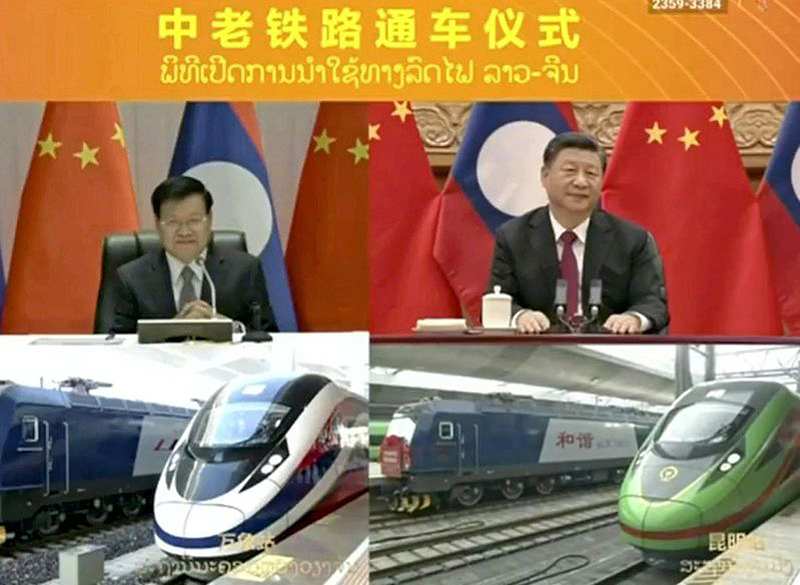
Laotian President Thongloun Sisoulith, above left, and Chinese President Xi Jinping watch the departure of high-speed trains online on Friday.
December 4, 2021
BANGKOK / HONG KONG — Southeast Asian countries are increasingly wary of China’s efforts to expand its influence by participating in railway network projects in the region.
On Friday, a high-speed railway connecting China and Laos, a landlocked country in Southeast Asia, was officially opened. Chinese President Xi Jinping and Laotian President Thongloun Sisoulith held online talks on the day and agreed to deepen cooperation, using the railway — a key project in China’s “One Belt, One Road” economic mega initiative — as a foothold.
“We’ll continue to communicate strategically with Laos and jointly seek the high-quality development of the One Belt, One Road to build a solid community sharing a common destiny,” Xi said at the talks, according to China Central Television and other media.
In response, the Laotian counterpart said, “The railway was realized with China’s support and we feel indebted to them.”
He also said: “Laos has benefited from the One Belt, One Road initiative. We’ll further strengthen our strategic communication.”
With a total length of about 1,000 kilometers, the railway connects Kunming in China’s Yunnan Province with Vientiane, the capital of Laos, in about 10 hours.
3½ hours to border
Thursday marked Laos’s National Day. At a ceremony held in Vientiane, participants prayed for the safety of the newly built railway. According to Laotian state media and other sources, Laotian Prime Minister Phankham Viphavanh attended the ceremony.
Train cars were manufactured in China and named “Lane Xang” after a historic Laotian kingdom.
In Laos, the train runs more than 400 kilometers from Vientiane to Boten at the Chinese border in about 3½ hours, significantly reducing travel time. It sometimes takes more than a day to travel by car.
“Laos has high expectations for an increase in exports of its agricultural products and an influx of tourists via the railway,” an expert on Laos said.
The high-speed rail project was carried out by a joint venture set up by China and Laos. The Laotian side covered most of its share of the construction costs through loans extended by a Chinese government-affiliated financial institution and other funds.
However, it has been pointed out that if the railway becomes unprofitable and repayments fall into arrears, Laos may find itself caught in what is called “a debt trap,” in which the country will be forced to transfer its interests in the railway to the Chinese side.
According to a report compiled by a private U.S. research agency in September, Laos’ total debt to China is 64.8% of its GDP, the highest such ratio in the world. Therefore, Laos’ ability to repay the debt has been called into question.
Meanwhile, China apparently aims to use its stronger ties with Laos as a tool to restrain Vietnam, which borders both countries. Vietnam has strong wariness toward Beijing in light of the “special relationship” between Vietnam and Laos as “brother countries” of the Indochina region.
“China is aiming to soften Vietnam’s stance toward Beijing by showcasing that Laos has taken a major pro-China turn,” a Chinese researcher familiar with Sino-Vietnamese relations said.
Bangkok’s landmark terminal
Southeast Asian countries are hoping that the expansion of their railway networks will help spur the recovery of their economies, which have been in a slump due to the novel coronavirus pandemic. However, whether to proceed with the projects as part of China’s One Belt, One Road initiative will be the focus of attention.
In Malaysia and Singapore, a plan for a high-speed railway linking the two countries had been suspended due to its costs and other problems, but the project was resumed last month.
After a meeting with Malaysian Prime Minister Ismail Sabri Yaacob late last month, Singaporean Prime Minister Lee Hsien Loong said that Singapore received a proposal from the Malaysian side to revive the project.
In Thailand, construction has begun for a part of a new high-speed railway, with plans to connect it to the newly completed Laos railway in the future. Bang Sue Grand Station, located in the northern part of Bangkok, is to become fully operational later this month as one of the largest railway terminals in Southeast Asia.
Thailand plans to finance the construction of the railway on its own — a move that is believed to be aimed at avoiding China’s excessive interference. “[Southeast Asian] countries are trying to expand profits while restraining China’s influence,” diplomatic sources said.
"World" POPULAR ARTICLE
-

8 Japanese Nationals Stranded on Indonesia’s Sumatra Island
-

Mozambican Cooking Class Held in Matsuyama, Ehime Pref.; Participants Don Aprons, Bandanas Made from Traditional Mozambique Fabric
-

China to Impose Sanctions on Shigeru Iwasaki, Former Head of Japan’s Self-Defense Forces, Who Serves as Adviser to Taiwan’s Executive Branch
-

U.S. Senate Resolution Backs Japan, Condemns China’s Pressure
-

South Korea’s Top Court Dismisses Nippon Steel Appeal in Lawsuit over Requisitioned Worker
JN ACCESS RANKING
-

Keidanren Chairman Yoshinobu Tsutsui Visits Kashiwazaki-Kariwa Nuclear Power Plant; Inspects New Emergency Safety System
-

Tokyo Economic Security Forum to Hold Inaugural Meeting Amid Tense Global Environment
-

Imports of Rare Earths from China Facing Delays, May Be Caused by Deterioration of Japan-China Relations
-

University of Tokyo Professor Discusses Japanese Economic Security in Interview Ahead of Forum
-

Japan Pulls out of Vietnam Nuclear Project, Complicating Hanoi’s Power Plans






















